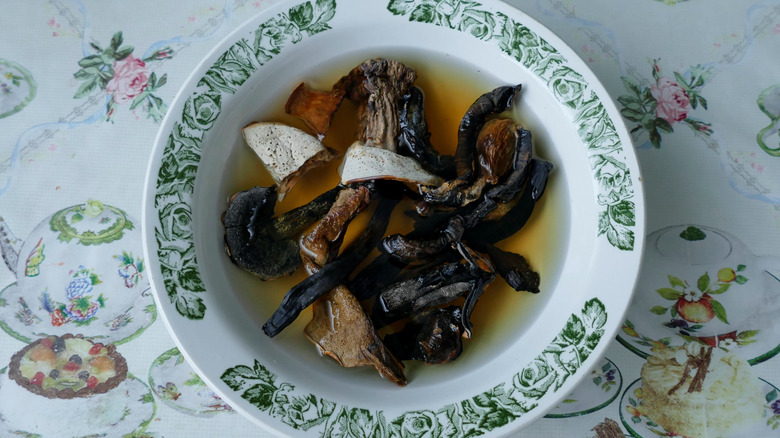For Ultimate Flavor, Don't Just Soak Your Dried Mushrooms In Water
Dried mushrooms tend to be either underrated or misunderstood as a culinary ingredient. After all, as Chef Katie Button told Food & Wine, there's a preconceived notion that "fresh is always better." However, that's not strictly true, especially regarding dehydrated fungi.
As shelf-stable produce, their value is immense: Dried mushrooms can last years in a pantry if stored correctly. Moreover, they add a touch of earthy goodness to any meal they're incorporated into, like this creamy porcini mushroom risotto. However, there's a slight hiccup often encountered with dried mushrooms, specifically when reconstituting them. Most recipes people come across instruct them to rehydrate the tasty ingredient with water. While this does get the deed done, it also does nothing in the way of adding flavor.
Some may argue water is a valuable component, especially when mellowing out a strong taste in a dish or ingredient, due to its intrinsic ability to dilute. However, sometimes you don't need to weaken but rather enhance. As a result, water isn't going to fit the bill here.
Try using stock or wine
Whether dry or fresh, mushrooms contain many delectable features, usually described using the word "umami." Mushrooms already possess tons of natural flavor, but why not incorporate more?
This is where wine or stock comes in, since mushrooms are especially porous. So, a flavorful liquid is a great choice when further enriching the ingredient before adding it to a meal. And this is especially true if the recipe already calls for such an addition otherwise.
After all, why go through the trouble of creating a complex and beautiful meal, such as this braised short ribs with berries, if you're only going to undermine your efforts by not also including the grappa and stock (already called for in the recipe) during the rehydration process? Not only does this replace an unneeded ingredient — water — but it will also add an extra bit of fulfilling earthiness to the liquids. And that's good news, because those flavors will then be reincorporated into the overall dish.
Other things to consider when using dried mushrooms
When rehydrating, a hot liquid is needed, and there are two ways to go. You could bring the fluid to a boil and essentially steep the mushroom. Or you could cook both components together and bring them to a simmer.
If you're using wine (or any other alcohol, for that matter), keep in mind that alcohol evaporates, but often not entirely so. Boiling liquid courage for 15 minutes still leaves 40% of the booze, and even doubling the time only removes another 5%. It's diminishing returns. So, if you don't want leftover hooch, you might be better off using stock.
Also, make sure your ingredients are entirely immersed during reconstitution. After all, because of the porous nature of dried mushrooms, they have less density, which is a determining factor in creating buoyancy. As a result, they will float, leaving their topsides exposed to the air. Still, as noted by Bon Appétit, Chef Trigg Brown has devised a clever solution to the problem: a French press. This makes sense, because most French presses include a type of plunger, which is applicable here since you can force the dried mushrooms to stay submerged within the device.
Nevertheless, regardless of whichever one you choose, selecting wine or stock instead of water is an excellent way to add more flavor to a dish. Additionally, it cuts some corners by reusing the tasty fluids most recipes require anyways when cooking.


